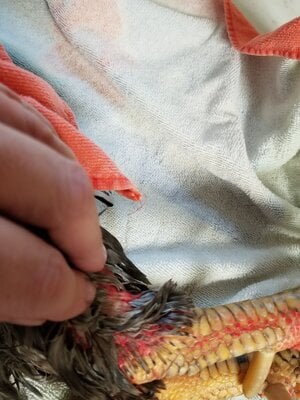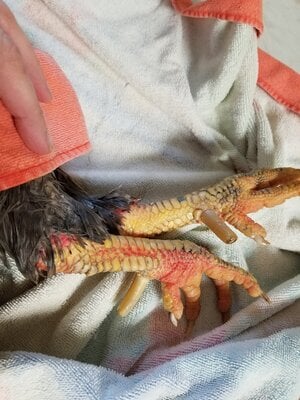I'm gonna disagree about it being hormone flush.. which I have not yet seen above the feathers like that.. it does look similar to hormonal flushing described by others.. but something isn't adding up for ME.Please advise, I have a rooster that I have been treating for 10+ days now. It is not bumble foot, and he does not have mites - (these were my first two thoughts with his condition). Both of his feet are red and swollen, one more than the other, he has a red stripe down his leg, and at the top of his leg where the feathers begin is very inflamed, swollen glands, bright red and painful. this goes up about 1/4 inch or 1/2 inch. I have actually been treating him with Epsom salt baths, and applying antibiotic ointment as well as some essential oils to his legs. I did break down and take him to my vet on Dec. 30, she agreed it was not bumble foot or mites (I previously treated him and the coop for mites) she did give him a treatment for mites as a precaution, and gave me an antibiotic. But after days of this treatment he is really not improving much... any one have any ideas on how to help him? He is a sweet guy, and I do not want to loose him. He is in a cage in our garage, and I am treating his legs at least once a day, sometimes twice a day.


Is there any feverish heat coming off of it, or does he react like he's in pain when you touch it by pulling way or..
Some "essential" oils can cause burns.. what were you applying? Let's see what the skin looks like below his vent?
What mites were treated for in the coop.. some only come out to feed and don't live on the host.
What is his standard feed routine including treats and supplements? 1 year old you say.. is he eating, drinking, hanging out with the flock, mounting, crowing? What breed, can we see a whole body pic including eyes and comb please?
NO that red above the feathers is 100% not normal IMO.. IVE never seen it without a parasitic infection. WHAT was used to treat for mites and were any actually seen?











